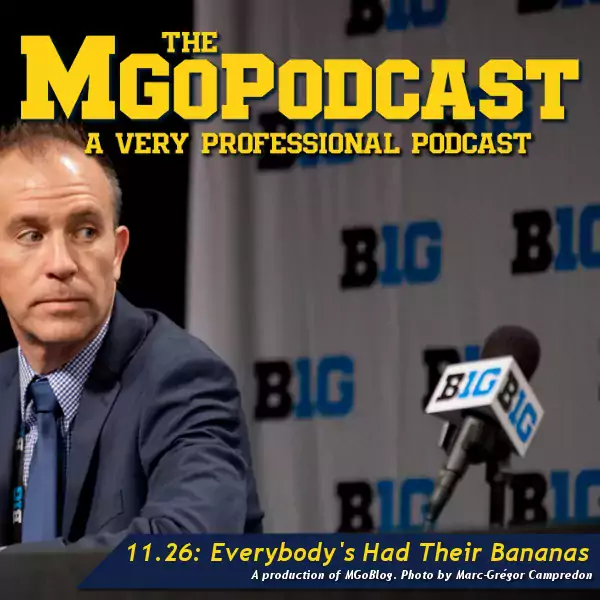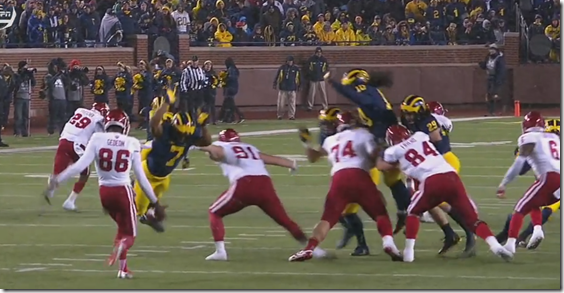2016 indiana

1 hour and 42 minutes
We can do this because people support us. You should support them! The show is presented by UGP & The Bo Store, and if it wasn’t for Rishi and Ryan we’d be furloughed SBNation writers right now. Proceeds from the "Those Who Stay Home" collection are going to support our front line workers at Michigan Medicine.
Our associate sponsors are also key to all of this: HomeSure Lending, Ann Arbor Elder Law, the Residence Inn Ann Arbor Downtown, the University of Michigan Alumni Association, Michigan Law Grad, Human Element, The Phil Klein Insurance Group, and FuegoBox
[Hit THE JUMP for the writeup and the player]
A few years ago it was de rigueur on this site to talk about how college rules allowed NCAA teams to use a different style of punting, and that this style (called spread or shield) of punting was demonstrably superior to NFL-style (tornado). Michigan has swung between them in recent years. Carr tested out something like shield punting in 2003 then scrapped it when it cost him a game against Iowa. Rodriguez took us to spread punting along with spread offense, and Hoke returned the program to pro-style as was his wont.
In 2015 Harbaugh brought in special teams guru John Baxter and the spread was once again installed, presumably for good. Then Baxter left, and this year Michigan used both. At first we wondered if this was, like under Hoke, some relic of a coaching staff that strove to be pro-like in everything. But as the punt blocks, and near punt blocks, and running-intos that by all rights should have been punt blocks piled up, a new thought emerged: maybe Michigan thinks they’ve solved the spread punt.
Shield punting refresher
For a full explanation of spread punting and a comparison to NFL-style see my 2014 article or watch the Joe Daniel Youtube. Here’s a graphic:
The splits are huge: two yards between the snapper and the guards, and two more yards until the next guy. You don’t care who comes up the A gaps—the only thing the guys on the line of scrimmage have to do is redirect the man lined up outside of them then get downfield (you don’t want your snapper involved in blocking).
The three guys standing about 7 yards back are the “shield”. You want big burly dudes for your shield, and you tell them the Grand Canyon is just behind their heels so they’d better not give an inch. By not giving an inch, they create an eye in the middle of the storm for the punter to safely get the punt off.
Everyone else just has to force the attackers to widen to the point where they can’t get back inside in time to affect the punt. That’s why the guards split so far apart: anyone going outside of them should presumably be too far outside to affect the punt. Anyone coming up the middle will get stuck behind an immovable wall of beef.
In the linked video, Daniel mentions the way to attack it is put four guys into those big “A” gaps, because that could overwhelm the shield. The way the shield would deal with this is block out man-to-man, and let the guys in the A gaps try to get around the shield. As long as your three-man shield can still stop four A-gap rushers, you’ve got a sound punt blocking strategy with two to four more guys releasing downfield than you would in an NFL-style punt.
So…
[After the JUMP we get around the shield]
[Bryan Fuller]
The title of the post still says “Post-Indiana,” but I seriously considered bucking convention and naming it “Pre-Ohio State.” With the stakes of The Game as high as they’ve been in a decade, it only felt right to look at where the two teams’ advanced stats are similar and where they’re different.
Still, it’s worth discussing what happened against Indiana. The offense took a fairly large hit in overall efficiency, falling from 23rd to 41st in success rate. The rushing offense’s success rate saw a nearly identical drop in the national rankings, falling from 21st to 42nd. The passing offense did even worse, with the success rate falling from 45.3% to 42.5% and from 26th to 50th. On standard downs, Michigan’s offensive success rate only dropped from 51.5% to 49.5%, but their ranking tumbled from 22nd to 43rd. The offense fared worse on passing downs, with their success rate dropping from 34.4% (39th overall) to 31.5% (62nd overall). The offense had a difficult time keeping on track, and their inability to pick up the necessary yardage to stay in manageable down-and-distance situations led to the drops in success rate. Of note is that the offense struggled in that department across the board (passing, rushing, standard vs. passing down, etc.) but with little impact on their other numbers, which stayed fairly stable. A few long runs helped keep the offense’s explosive play-realted numbers afloat.
The defense, already at or near the top of most categories, saw little movement. One of the bigger changes was in the defense’s IsoPPP, the number Bill Connelly uses to track explosiveness; Michigan moved up from ninth to fourth. That’s pretty much it. The defense is good. The stats are good. They both remained so against Indiana.
[After THE JUMP: how Michigan stacks up against Ohio State according to S&P+ and FEI]



11